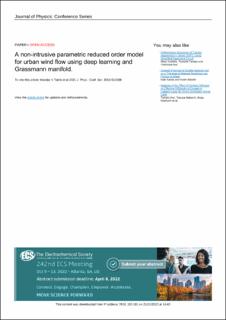| dc.contributor.author | Tabib, Mandar | |
| dc.contributor.author | Pawar, Suraj | |
| dc.contributor.author | Ahmed, Shady E | |
| dc.contributor.author | Rasheed, Adil | |
| dc.contributor.author | San, Omer | |
| dc.date.accessioned | 2022-08-05T12:36:27Z | |
| dc.date.available | 2022-08-05T12:36:27Z | |
| dc.date.created | 2021-09-23T22:57:12Z | |
| dc.date.issued | 2021 | |
| dc.identifier.citation | Journal of Physics: Conference Series (JPCS). 2021, 2018, 012038. | en_US |
| dc.identifier.issn | 1742-6588 | |
| dc.identifier.uri | https://hdl.handle.net/11250/3010377 | |
| dc.description.abstract | In this study, we present a parametric non-intrusive reduced order modeling framework as a potential digital twin enabler for fluid flow related applications. The case study considered here involves building-induced flows and turbulence with inlet turbulence value as a parameter. The framework proposed employs a Grassmann manifold interpolation approach (GI) for obtaining basis functions corresponding to new values of parameter, and exploits the time series prediction capability of long short-term memory (LSTM) recurrent neural network for obtaining temporal coefficients associated with the new basis functions. The methodology works in the following way: (i) in the training phase, the LSTM model is trained on the modal coefficients extracted from the high-resolution data using proper orthogonal decomposition (POD) transform for the known values of parameter, and (ii) in the testing phase, the trained model predicts the modal coefficients for the total time recursively based on the initial time history for the new value of parameter. Then, we reconstruct the flow fields for the new value of parameter (new inlet turbulent value) using the GI modulated basis functions and LSTM predicted associated temporal coefficients. To assess the performance of the proposed model, the ROM-LG predictions are compared with the high-dimensional full-order model solutions using L1 and L2 error analyses as well as with the conventional POD based ROM (ROM-POD) solutions. The results indicate that the non-intrusive ROM (ROM-LG) framework yields a stable solution for the velocity fields and for short-term prediction of dynamic turbulent kinetic energy fields. This work has scope for further development and will be useful for building-integrated wind energy and urban drone operation in a smart-city digital twin platform. | en_US |
| dc.language.iso | eng | en_US |
| dc.publisher | IOP | en_US |
| dc.rights | Navngivelse 4.0 Internasjonal | * |
| dc.rights.uri | http://creativecommons.org/licenses/by/4.0/deed.no | * |
| dc.title | A non-intrusive parametric reduced order model for urban wind flow using deep learning and Grassmann manifold | en_US |
| dc.type | Peer reviewed | en_US |
| dc.type | Journal article | en_US |
| dc.description.version | publishedVersion | en_US |
| dc.source.pagenumber | 10 | en_US |
| dc.source.volume | 2018 | en_US |
| dc.source.journal | Journal of Physics: Conference Series (JPCS) | en_US |
| dc.identifier.doi | 10.1088/1742-6596/2018/1/012038 | |
| dc.identifier.cristin | 1937936 | |
| dc.source.articlenumber | 012038 | en_US |
| cristin.ispublished | true | |
| cristin.fulltext | original | |
| cristin.qualitycode | 1 | |

